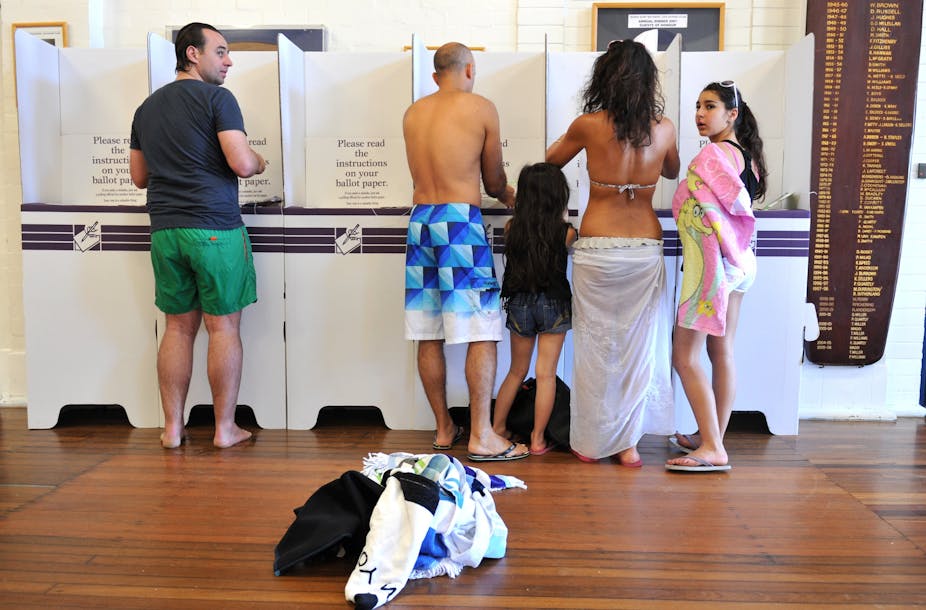The major parties have reportedly strenuously objected to the proposed New South Wales federal electoral boundary changes. These have the capacity to change the demographics and political leanings of a handful of seats.
So, any redistribution of electoral boundaries may significantly impact how parties are represented in the parliament. But how does Australia’s system of changing seat boundaries actually work?
How it happens
Electoral redistribution is the redrawing of seat boundaries to ensure, as precisely as is practicable, that each state and territory gains representation in the House of Representatives in proportion to their population, and that there is a similar number of voters in each electorate for a given state or territory at an election.
To achieve this, the Australian Electoral Commission’s Redistribution Committee is required to consider four express criteria when changing an electorate’s boundaries:
the community of interests within the proposed electorate (including economic, social and regional interests);
the means of communication and travel within the proposed electorate;
the physical features and area of the proposed electorate; and
the boundaries of the existing divisions in the state or territory.
The committee seeks to preserve the existing boundaries as much as possible, but that is less important than the other three criteria. It has also been suggested that an:
… unspoken criterion [provides] that redistributions ought to minimise distortion or disruption of the likely translation of votes to seats, given an essentially two-party lower house.
The public – including political parties – may make submissions to the Electoral Commissioner containing suggestions, comments and objections in advance of boundaries being decided. However, the government plays no role in amending the outcome of what the Redistribution Committee determines. The committee must remain impartial.
This impartiality was not always a feature of Australia’s electoral laws. Following Federation, the government and the parliament commonly engaged in gerrymandering, malapportionment and other overtly partisan incursions.
In recent decades, however, electoral redistribution has been driven less by partisan politics than by population dynamics. Successive electoral reforms have diminished the process’ discretionary nature. Federal electoral law now provides an exhaustive list of redistribution triggers that leave no room for discretionary redistributions at the behest of the government or parliament.
Why do redistributions take place?
Since 1901 there have been 87 federal electoral redistributions, in addition to four “pre-distributions” in 1900 ahead of the first federal election.
Since the introduction of the mandatory and automatic triggers for redistribution in 1983, redistributions have increased in frequency from about once a decade to about one every five years.
Five distinct events can trigger redistributions:
executive or legislative initiative;
changes in the legislature’s size;
changes in the state’s population share;
malapportionment; and
the passage of time.
What are these? Which are still relevant today?
Executive or legislative initiative. Between 1901 and 1975, the government either rejected or ignored 35 redistributions proposed by the redistribution commissioners, often for the sake of political advantage. While this discretionary trigger has been historically significant – resulting in 15% of all redistributions – there is no longer any room for for government or parliament to request discretionary redistributions.
Changing size of the legislature. Federal parliament’s size was twice increased (1948 and 1983) and led to the automatic triggering of ten state-wide redistributions and three additional redistributions at the government’s discretion to accommodate the new allocations of electorates.
Change in state population share. The constitutional principle that the number of electorates be proportional to each state’s population recognises that populations are dynamic and that each state’s population share will change over time in response to regional variations in fertility, mortality and migration.
As their relative populations change, electorates will be lost from one state and gained in another. This triggers redistributions in both states. NSW is set to lose one electorate to Western Australia. Changes in the spatial distribution of populations across states and territories have accounted for about 45% of all redistributions.
Malapportionment. Malapportionment refers to the departure from the democratic principle of “one vote, one value”, which requires single-member electoral districts to contain approximately equal numbers of voters. Australia permits a malapportionment variance of up to 10%. It can be redressed by either expanding or contracting an electorate’s geographical boundaries to include additional or fewer voters.
Malapportionment has triggered about 14% of all redistributions. Redistributions have reduced the high degree of malapportionment. The number of voters enrolled in a seat frequently differed from the average state enrolment by 20% over the first seven decades of the 20th century. Over the past 30 years this has been reduced to 2-7% of the average state enrolment.
Passage of time. It was not until the High Court mandated that the entitlement of each state be determined prior to every federal election that the passage of time became a mandated trigger.
The 1983 electoral reforms refined this requirement by mandating a further redistribution if seven years had elapsed since the last redistribution in a state. This allowed three general elections to be held on one set of boundaries (unless a redistribution had been triggered another way), given the three-year parliamentary term.
This trigger accounts for about 15% of all redistributions. More significantly, it has accounted for nearly all redistributions since the 1983 reforms.
It has not been the Constitution but federal legislation that has had the most significant impact on electoral redistribution and voter equality. The most important legislative change has been the establishment of the independent electoral commission.

